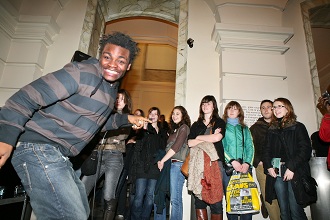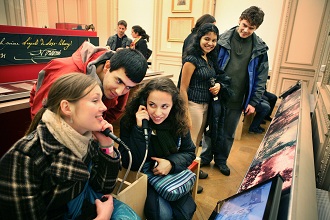
The BELvue Museum, which opened 21 July 2005 to celebrate the 175th anniversary of the creation of Belgium, is much more than a museum. The 18th century heritage building, next to the Royal Palace, is an activity centre - a living museum - where visitors, particularly young people, can experience democracy and history through the permanent collection, dynamic temporary exhibitions and activities for the general public and the educational sector. More than 250,000 visitors have experienced the BELvue in its first five years, located at the heart of the city at the crossroads of Belgian history.
The BELvue is located in a beautiful heritage building, close to the city's famous art museums and the elegant Royal Park. It is a former hotel, built in the late 18th century on the ruins of the old castles of the 11th century Dukes of Brabant. The hotel - and now the museum - is located at the scene of the 1830 Belgian Revolution, which led to independence. The King Baudouin Foundation (KBF) created the BELvue Fund with a view to creating a museum as a place where young people and other visitors could learn about and interpret Belgium's history, socioeconomic development, institutions and the monarchy. KBF is an independent public benefit foundation that is active in Europe and internationally. Founded on the 25th anniversary of the reign of Baudouin I of Belgium, the Foundation is committed to creating better justice, democracy and diversity in society.
The museum is managed by the BELvue Fund, housed within the King Baudouin Foundation. The Fund is endowed, with the museum using 4% to 5% of the market value of the endowment for operational expenses. The BELvue also opens its doors to an average 30 to 40 private events per year. These and other commercial activities, including the successful restaurant and bookshop, generate about 25% of the museum's annual budget. The BELvue also has a close partnership with the archaeological site of the Coudenberg, located underneath the museum, neighbouring streets and buildings. Here, visitors explore the remains of Charles V's palace, which was damaged by fire in 1731. The BELvue manages the ticketing for this site and rental for special events.
History, democracy and education
Nine rooms are dedicated to the milestones of Belgium''s history since 1830, with the reigns of each of the country's monarchs depicted in the corridors in their role as head of state and the view their countrymen had of them. More than 1.500 documents, historical photographs, film archives and artefacts portray key moments in the country's history. Because the BELvue does not have its own collection, we drew on the reserves of Belgium's most important museums to create this exhibition. Creating a museum dedicated to history was no easy task. There are many sensitivities to balance in Belgium, a country with many intersecting lines of culture, religion, politics and language. To create a "politically correct" exhibition, we created a scientific committee comprised of historians from the country's various communities.
The displays are interactive and engaging - a format that brings history alive and encourages visitors come to their own conclusions rather than being confronted with a traditional interpretation of people, places and events.
Since 2005, 16 temporary exhibitions have been held on topics relating to history, democracy or cultural heritage. These exhibits examine in greater depth some of the themes from the permanent exhibit and attract new visitors to the museum. Once a year, the BELvue hosts an exhibition of the King Baudouin Foundation's Heritage Fund, showcasing the artistic heritage of the country. The BELvue's Education Department organises free activities and classes for young people aged 10 to 18 on the values, institutions and challenges of democracy, as well as various aspects of Belgian history. Interviews with the parliamentarians of the federal and regional Belgian parliaments and chats with European parliamentarians give participants hands on experience with democracy and a deeper understanding of national and European political processes. The Education Department also uses the permanent and temporary exhibitions to raise young people's awareness about the history of Belgian democracy. In addition, the department can count on the collaboration and support of the two education ministries in our country. Teachers' materials are available for use in schools on the subjects of education and citizenship. Courses are also organised for teachers who want to teach their students about democracy, citizenship and the European Union.
 Designed by young people for young people
Designed by young people for young people
Through creative outreach and engagement, the BELvue has attracted thousands of young people, many of whom have never visited a museum. The secret to success? Activities are designed by young people for young people, which means the activities appeal to them and are popular. In addition, admission to the museum is free for them.
The former museum housed in the building used to be a rather stuffy place portraying Belgian royalty. Today, the BELvue is not only about history and democracy; it is about creating the Belgium of today and tomorrow. The participation of young people in this process is critical, which is why the museum focuses on this target audience.
Museum Night Fever, organised in partnership with youth associations, has proved a huge success. The first, held in March 2008, brought beat boxing, break dancing and an exhibit of young artists to more than 3,000 visitors over the course of a few hours. In 2009 and 2010, more than 9,000 young people have participated in Museum Night Fever.
The museum's elegant, open garden, has hosted many live performances, including a fashion show staged by young artists. Other activities include a celebration of multicultural dialogue where young people could link up with their peers in 21 EU member states to explore Europe's diverse cultural identities by using photography, film and music to create double portraits.
The challenge of change
The most challenging aspect of managing the BELvue is working with a small team of 10, including four teachers, who frequently must take on different or new tasks. The constantly changing nature of our activities requires people to be responsive, flexible and open-minded. This dynamism is the key because we must respond quickly to current events and new needs from the public, which leads to constant re-organisation. It's an ongoing challenge to find the right external consultants to work with, such as exhibitions and communications specialists, who understand our goals and help us to communicate our vision to the public.
Partnerships are the key for content
All of our partnerships are essential. Because of our small team we often work with partners to organise events. But partnerships also enrich our opportunities and allow us to diversify our programmes. Since the BELvue does not have its own collection or scientific collaborators, our exhibition policy is to collaborate with other museums such as the In Flanders Fields Museum and the Jewish Museum of Deportation and Resistance. These collaborations allow the BELvue to host exhibitions that can highlight a certain period of Belgian history, or deepen a certain topic with the expertise of an institution that has this knowledge. As a small team, with limited space and limited resources, partnerships allow us to widen our reach, broaden our space and augment our capacities. It also keeps us open-minded and flexible, avoiding stagnation and self-centeredness.
Keeping an eye on the future
By attracting young people and the general public to the BELvue, we hope to keep raising public awareness about the values and the importance of democracy and citizenship not only through learning about history, but also through insights on the Belgium and Europe of today and tomorrow. Being in Brussels, the capital of Europe, is not only an added value, but also creates an extra responsibility for the BELvue. In this way, we try to contribute to the mission of the King Baudouin Foundation: working together for a better society.